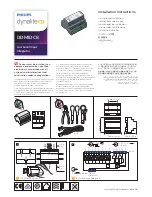
79
•
When untagged packets enter the Residential Gateway from a LAN port on the
public network and leave from the WAN port of the Residential Gateway, they will be
added the PVID and P-Bit value of the incoming LAN port.
•
When tagged packets enter the Residential Gateway from a LAN port on the public
network and leave from the WAN port, the Residential Gateway will process them
according to their original VLAN tags. If the original VLAN tags of the tagged packets
are the same as the WAN port’s PVID, the packets will be untagged by the
Residential Gateway. Otherwise, they will keep their original VLAN tag when they
leave the Residential Gateway.
•
When untagged packets enter the Residential Gateway from a LAN port on the
private network and leave from the WAN port, they will be added the PVID and P-Bit
value of the WAN interface from which they leave the Residential Gateway.
•
When a LAN port is allocated to the public network, you can specify its VLAN ID in
the text box and select its P-Bit value in the pull-down menu. But when a LAN port is
allocated to the private network, its VLAN ID and P-Bit value cannot be changed.
3.4.3 DDNS
DDNS stands for “Dynamic Domain Name Service”. It allows a host to bind with a permanent
domain name so the host can be found on the internet with this domain name. With DDNS, the
network administrator can access the Residential Gateway with a permanent domain name even if
it is often assigned different IP addresses by DHCP. And users on the Internet can access the
server (such as the web service) on the private network by the domain name of the Residential
Gateway. They do not have to access the server by an IP address which is usually not as easy to
remember as a domain name. Select
DDNS
from the
Setup
sub menu bar.
Then,
DDNS
screen
page appears as follows.
















































